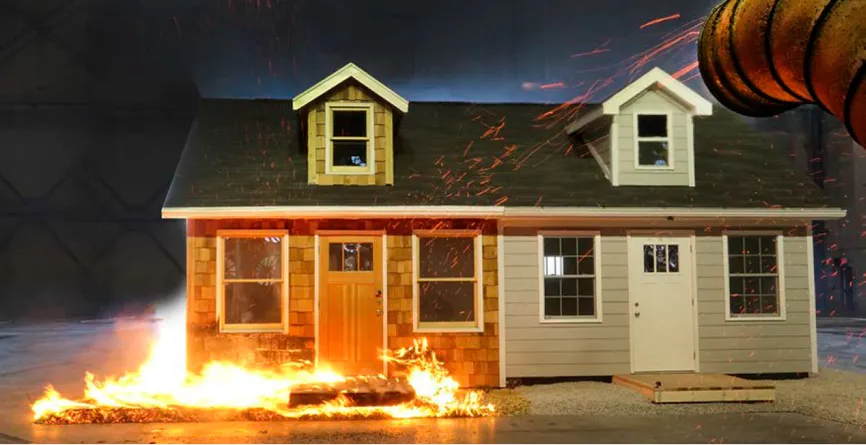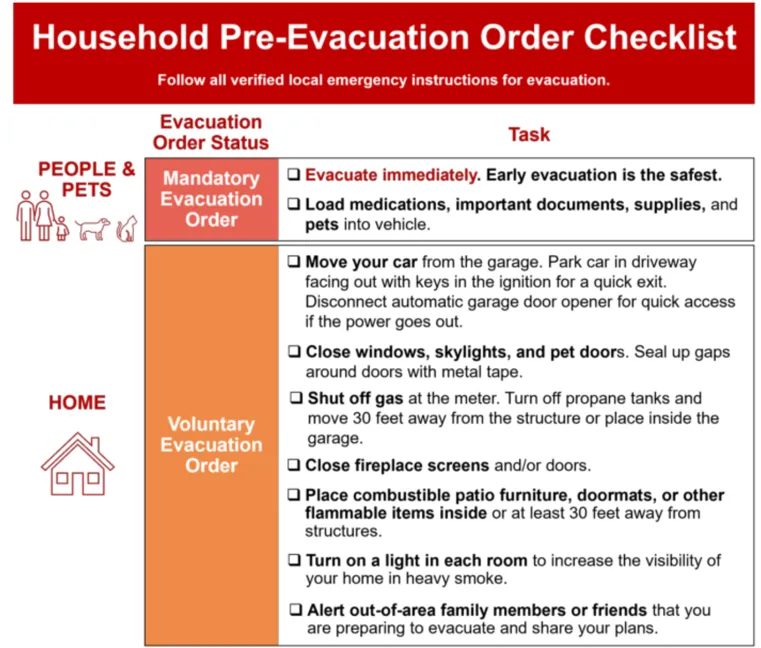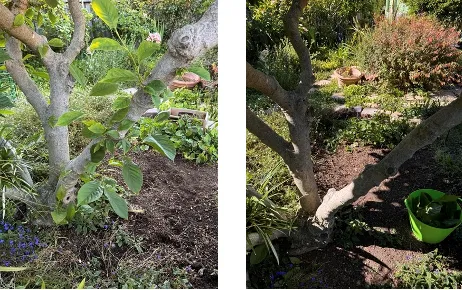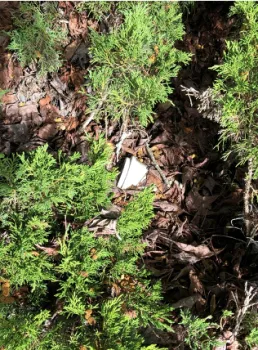By Marilyn Saarni, Co-Lead of the Firewise Gardening Project and Rescape-certified in Sustainable Firescaping
The massive devastation and scope of the Los Angeles fires have touched all of us Californians. Many of us have friends or family members who have lost homes, faced evacuation or are unsure when they can return. The threat continues as the Santa Ana winds return, leaving communities on edge. Tragically, lives have been lost—many of them seniors or individuals with disabilities who were unable to evacuate on their own.

Defensible Zone 0 (0–5-foot noncombustible zone around the structure) increases the chances of a home’s survival from an ember attack. From Suburban Wildfire Adaptation Road Maps: A Path To Coexisting with Wildfires, 2020, © The Insurance Institute for Business & Home Safety.
Long-time Bay Area residents know that many of our neighborhoods face similar conditions. Our own turbulent Diablo winds blow out of the Great Basin and are most prevalent September through November. Climate change is intensifying both the Diablo and Santa Ana winds and extending their seasons. Earlier this month, the National Weather System warned of a Diablo wind event, with projected wind speeds of 60MPH and strong gusts. Fortunately, our early rainy season has kept relative humidity high, lessening the risk of a destructive wildfire. By contrast, Santa Ana winds have a winter season—and Los Angeles is enduring an extended drought, with no significant rainfall since February 2024.
Dried-out chaparral and grasslands were primed to ignite. Then the winds blasted the embers into residential neighborhoods—even into areas previously considered safe from such overwhelming wildfire conditions. As has happened in other catastrophic wildfires, firefighting resources—though they pre-staged firefighters and equipment, quickly mobilized to fight hot spots, and received swift support from outside agencies—could not match the scale of these fires. Infrastructure also failed, with water pressure collapsing. While people are quick to cast blame these fires were beyond anything seen before.
Investigations into the origin of the fires are ongoing while search and rescue teams continue recovering victims. Animal recovery teams are locating pets, livestock and wildlife that survived the fires but suffered injuries, taking them to emergency veterinary-staffed recovery centers. Insurance teams are also reaching out to clients to provide assistance. I encourage donations to leading groups, such as the Red Cross LA, LA Fire Department Foundation, Pasadena Humane Society, and World Central Kitchen. Research responsible charities assisting survivors and firefighters in Los Angeles at https://www.charitynavigator.org/losangelesfires.
What actions can we take to protect ourselves and our neighbors during a similar event? In our region, we face additional challenges: not only could the Diablo winds create overwhelming wildfire conditions, but we can also suffer from post-earthquake wildfires, when firefighting resources will be scarce.

From the UCANR Fire Network Evacuation Preparation site. Copyright UC Regents, courtesy of UC ANR.
FIRST: Prioritize lives. Every household should prepare and leave early when receiving evacuation warnings to avoid being trapped. Once you receive an evacuation alert or see fire approaching your home, evacuate immediately. Evacuation warnings are recommendations; evacuation alerts are mandatory and mean “leave now.”
Follow police evacuation guidance and get out of the way of emergency responders as you leave your area. For those evacuating hilly areas, watch this Firesafe Marin YouTube video on how to drive safely during a wildfire (one of the best videos on wildfire evacuation).
If you haven’t already, prepare a go-bag now. Peruse this sample list of what you may want to put into it, but customize it to fit your needs. It’s a good idea to personalize your list and review it annually. January is a good month for this task. Include long-sleeved shirts and heavy-duty long pants, preferably 100% cotton. Avoid polyester and other synthetic materials, as they can melt quickly. Embers can burn through them, reaching your skin quickly. Include boots or sturdy heavy-soled shoes and flame-resistant gloves, such as leather (again, no synthetics). If you have critical medications that need to be refrigerated, have a small, easy-to-carry ice box on hand, and stock it with ice on Red Flag Warning days to toss in your meds and walk out the door.
If your car is large enough, consider keeping certain supplies in it at all times during wildfire season—a first aid kit, emergency water and food supplies, a manual can opener, fire extinguisher, and a solar lantern (many models can also recharge your cell phone). As for go-bags themselves, backpacks are generally recommended—but if you’re unable to carry a backpack, devote a wheeled carry-on bag to be your “go-bag.” Keep your gas tank or battery charge ¾ full during wildfire season, and park vehicles front end out for quick and safe exits.
Remember your pets and livestock, too. Pre-planning is essential, especially for large livestock. To learn more, consult the resources at The Halter Project, a charity devoted to Animal Disaster Preparedness (they offer cool checklists!).

THIRD: Prepare your homes to be wildfire-resistant. This is where your gardening practices play a significant role. This is an excellent time of the year to implement your Zone 0 defensible zone. Remove all flammables and vegetation in the zone 0-5 feet wide around the entire perimeter of your house, deck, and outdoor structures such as sheds and greenhouses. While bare mineral earth (bare soil) is not flammable, for easier maintenance and firefighter access, it’s helpful to fill with hardscape-nonflammable materials such as pavers, rock, and gravel that is at least 3” thick. The latest research shows that the most vulnerable areas are under windows, near external doors, and at the external corners, where wind gusts tend to whip up embers. While Zone 0 guidance is 0-5 feet, research shows that 7 feet clearance from vegetation is better at corners.

Preserve sightlines along your driveway—especially where it meets the road. Keep plantings no higher than 4 feet so you can see people, downed trees and other hazards, emergency responders, etc. Consider creating an emergency evacuation exit through the back of your property and possibly negotiating with your neighbor to build a gate into your back fence.
No tree canopies should hang over your house or other structures. Trim your trees to keep a year-round clearance of at least 5 feet from roof lines—10 feet for big trees is wiser, as they can sway dangerously in 60-80 MPH winds. Limbing up and thinning the canopies of big trees, especially if they’re not clustered (clustering protects trees from being smashed up by high winds), can help by letting gusting winds with embers flow through while also ensuring that the tree maintains a strong structure. This doesn’t apply to young trees. Lower limbs are important to build trunk strength in young trees and should not be removed until those trees are at least 10+ feet tall. These maintenance actions depend on the specific tree species; it’s always best to consult a certified arborist before making drastic changes. Never remove more than a third of a tree’s canopy at one time.
Do you need to remove risky, flammable trees and shrubs? This is a tough decision many gardeners face, especially those with older landscapes. Plants that once were popular may now be recognized as high risk that regular maintenance cannot mitigate. Others are far enough from flammable structures that you can manage flammability through proper maintenance to reduce flammability. However, some plants present too much risk to you, your neighbors, and your community. This may be due to their location, the spread of their heavy littering (pine needles spread over long distances and accumulate in gutters, eaves, and roof crannies), or their risky trait of explosive spread of embers (plants like juniper, thuja or arborvitae, rosemary, Italian cypress, unmaintained palms, and bamboo).
I’m not covering home hardening here. But your home is the most flammable object in the landscape, not trees! Up to 90% of homes are lost due to ember penetration. Firewise landscaping is only part of what you must do to prepare for wildfire. You’ll have to invest in home hardening as well. Resources are available on Firesafe Marin’s website, while Living with Fire (University of Nevada) offers videos and workshops (including for building professionals).
Excellent resources:
UCANR’s newly launched Fire Network web resources: https://ucanr.edu/sites/fire/
CalFire customized Wildfire Preparedness Plans https://plan.readyforwildfire.org/en/survey
Valachovic, Quarles and Swain (2021) Reducing the Vulnerability of Building to Wildfire: Vegetation and Landscaping Guidance (UCANR Publication 8695, July 2021), https://anrcatalog.ucanr.edu/pdf/8695.pdf
Douglas Kent (2019, 2nd edition): Firescaping: Protecting Your Home with a Fire-Resistant Landscape
News to Grow By Firescaping Series:
Understanding Defensible Space Zone 0 (spring 2024 issue)
Understanding Defensible Space Zone 1 (summer 2024 issue)
Understanding Defensible Space Zone 2 (fall 2024 issue)

